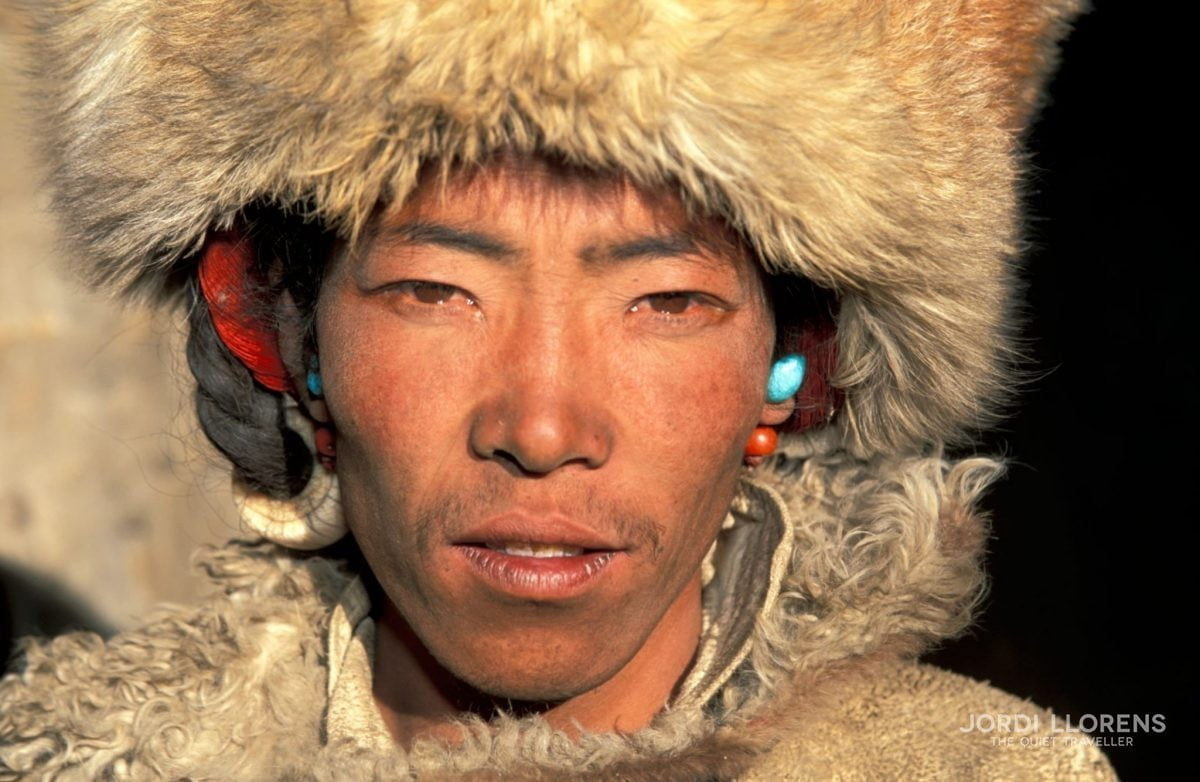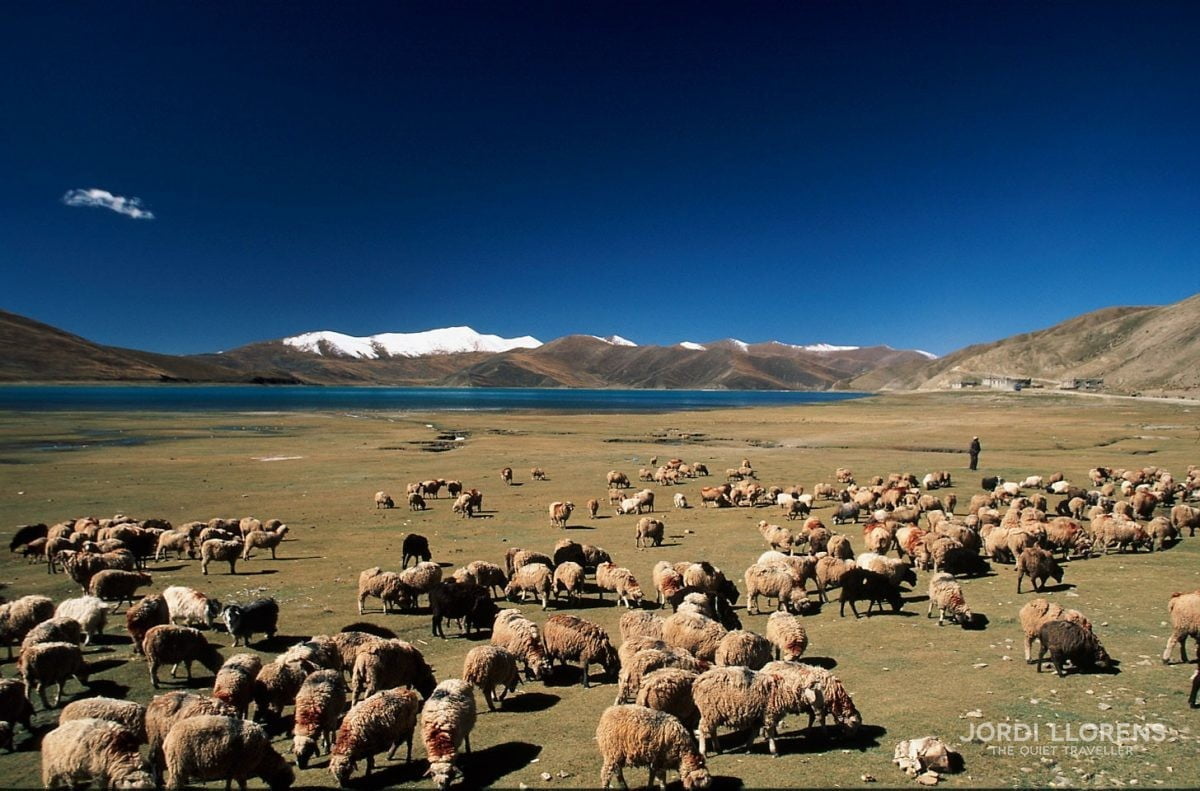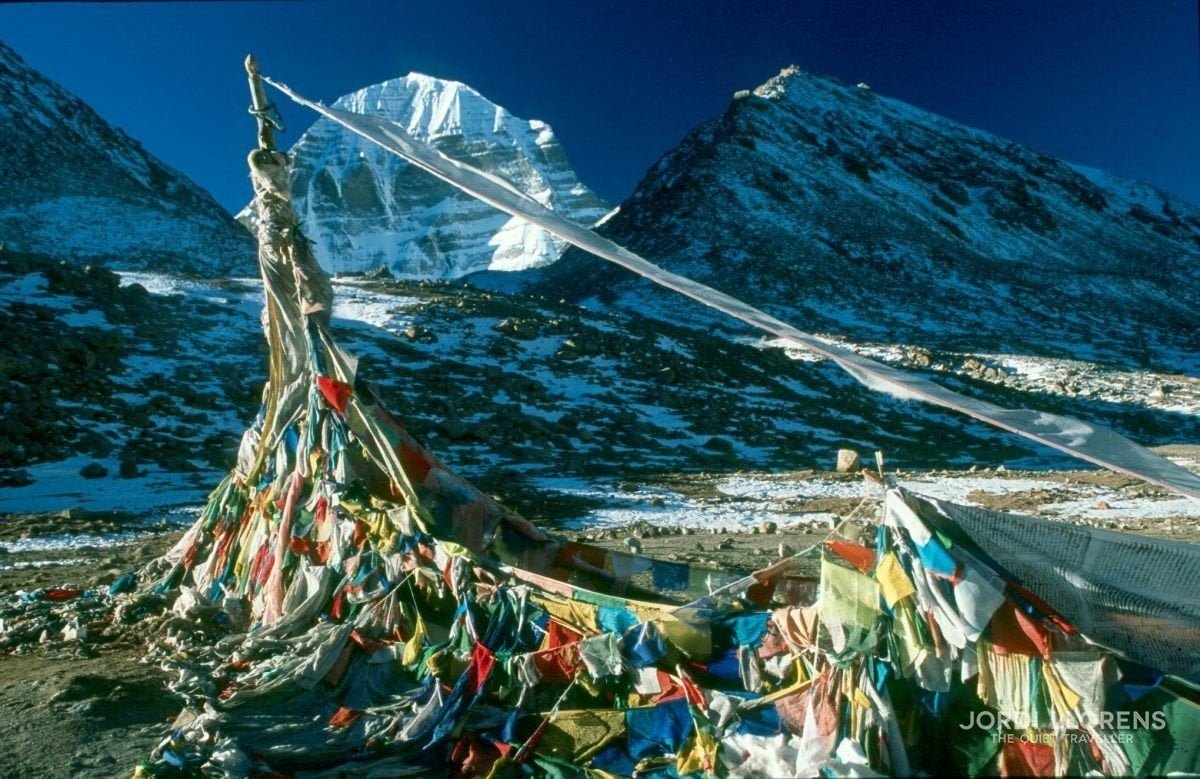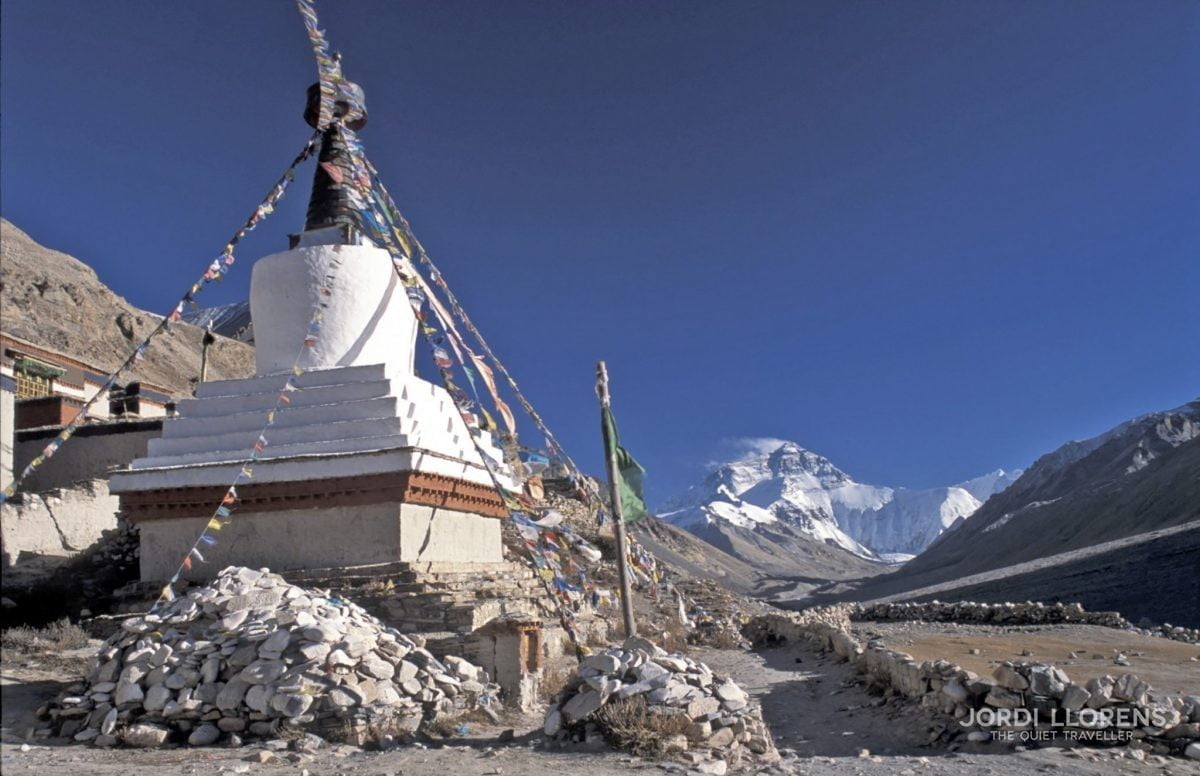Situated on the high planes of the Himalayas, Tibet lies at an average altitude of 5,000 metres above sea level, with splendid monasteries surrounded by some of the most beautiful natural scenery in the world.
And this was one of the reasons for my journey to Tibet. In reality, I had not planned anything; I sort of went to see who and what I would find. And this was how I arrived at Lhasa, my first destination, and the mythical Tibetan capital, which presents a contradictory appearance.
The Chinese part, which looks like a western city with its shopping centres and brand-name shops, is different from the Tibetan sector, which still keeps its traditional character, its network of alleys and street markets. Although the city has lost its old mystery under Chinese occupation, it has not lost its sacred and spiritual character.
Dominating the horizon is the Potala Palace , built in the XVIIth century by the fifth Dalai Lama and housing more than 1,000 rooms. What was once the home of the Dalai Lama is today a museum with only the top three floors open to the public. For me, after having seen it so many times on the television, it was like a dream come true and it really made an impression on me.

Potala palace, Lhasa
In the old part of town is the Jokhang Temple, built in the year 640 to house the image of Sakyamuni Buddha, today still the most venerated in the country and the cause of long pilgrimages. Inside, in the darkness and swallowed up in an atmosphere steeped in the aroma of incense, long queues form to receive the blessing.
Outside is Barkhor Square , a silent witness to serious incidents between the Chinese police and the Tibetans. I sit down in a corner, just watching the pilgrims who have come from all over the world and observe how their features and clothes give their origins away.
Lhasa is also the point where all of us travellers come in search of other travellers, in order to be able to share private transport to reach inhospitable places which public transport reaches only with difficulty. Although most arrive at or leave Kathmandu via Friendship Road, as the Chinese call it, I did not only want to know this road which crosses historic places with important monasteries. I also wanted to reach the Everest base camp and get to the most difficult adventure that Tibet offers – the desolate Western region, one of the most inaccessible places on the Earth. Transport hardly exists, the scenery is empty and impressive, the villages are remote and scarce, and yet this is where there is one of the most important centres of pilgrimage in the world – Kailash Mountain and Lake Manasarovar at its feet. It took me more than 4,000 kilometres in total to get to know remote Tibet, where faith touches the sky.

Inner courtyard of Lhasa houses
We started on asphalt roads but later reached tracks without asphalt where the dust got mixed up in the immensity of the landscape – lakes, dunes, snowy peaks – and there I was, without realising that my body had got used to the altitude.
Gyantse was my first contact with a Tibetan city apart from Lhasa. Lying in the fertile Nyang Chu valley, the city evokes romantic medieval images of Tibet before the Chinese occupation of ’59 and invites you to stroll along the main tree-lined avenue and narrow streets in search of deepest Tibetan cultural traditions. As you walk, you can see the perfect harmony that exists between the Tibetan towns and their surroundings. To me, their houses seem to be a perfect reflection of the way the Tibetans are – like themselves; their houses are simple but welcoming, poor but cheerful, tightly-sealed but open to the visitor. The stone houses have a flat roof on which to store yak dung, which is then used as fuel for cooking, the yak being the number one animal for Tibetans.
What was my impression of the Tibetans? They smile easily despite their difficult circumstances and their short stature is compensated by their great capacity for self-sacrifice. They are capable of transmitting their inner security and an irresistible combination of cleverness, naturalness and humour. Their copper-coloured hands and skin are permanently dirty and their Mongolian eyes are constantly irritated by the smoke of their kitchens. They live off the yak from which they get meat, cheese and fat, as well as ginke , or mountain barley, which they mix with tea and butter and which constitutes the local food staple.

Tibetan ethnic group
On the other hand, Tibet’s second city Shigatse is divided into two worlds: the Chinese with its wide asphalted avenues, and the poor Tibetan world with its medieval atmosphere created by its white, rectangular houses. Between these two worlds, the Tibetans have become second-class citizens in their own country.
Tashilumpo, the monastery which has been home to the Panchen Lama is the main reason for visiting the city. Few experiences can compare to a visit to a Buddhist monastery in Tibet and the show of passion demonstrated by the faithful there. Their interiors are immersed in darkness and the atmosphere is dominated by a strong, musty smell, coming from the hundreds of burning yak-fat candles, which the pilgrims take care to replace during their visits. Beautiful swathes of silk embroidered with gold thread hang from the columns, while the walls are decorated with shelves of figures of Buddha and religious figures. At the doors of the monastery there are crowds of pilgrims who never seem to tire of prostrating themselves, probably offering up their personal, secret mantra to Buddha. Inside the monks sit with crossed legs reciting mantras , with voices which seem to come from beyond the grave. Almost all of them are from small towns far away and are here because their families follow the old tradition that requires them to send one of their sons to the monastery.
However, climbing up Friendship Road which links Khatmandu and Lhasa, the sensation of approaching the origin of one of my great dreams sends shivers down my spine. I am passing through one of the most spectacular landscapes in the world, full of mountain passes, precipices and fantastic horizons. The road does not stop rising until it reaches the hair-raising height of 5,200 metres at the Lung-la Pass but before I arrive at the Everest base camp, I need to have a cup of tea with butter to get my strength back and quell my altitude sickness – and there was Everest and the whole of the Himalayas, impressive in all their splendour. It seemed like a dream, standing in front of the highest mountains in the world and I felt like I could embrace them. It is strange how small I felt at that moment and yet how large I felt too, for being so lucky to be there, accompanied by the main god of the Himalayas – Everest.

Pasturing in lake Namthso
I was getting deeper and deeper into the remotest part of Tibet, far away from everything. I could see that all around me was a great plain, which at times changed into a large lake with turquoise waters and at others became a desert. Everything was a sea of sand, stones and rocky mountains of mineral-like colours. I closed my eyes and a sensation of peace and harmony filled me, although the oxygen-poor air in my lungs made it hard for me to walk. I was listening to the sound of silence.
I quickly recovered the oxygen on reaching Kailash (6,714 m), the Tibetans’ sacred mountain, which is so admired and so worshipped. For Hindus and Buddhists equally, Mount Kailash is the physical and metaphysical centre of the universe. My mission, as if it were a pact with the gods, was to do kora with the pilgrims. For Tibetans kora is walking clockwise around sacred buildings or places, whether it is a monastery, a lake or a mountain.
I covered 52 kilometres in 3 days. The way was not hard but each step up there represents 100 down here and the truth is that walking at altitudes of 5,000 metres made my body feel the effects of the lack of oxygen and the tiredness was permanent. Despite the difficulties though, I was even more impressed by the happiness of the pilgrims who accompanied me, a joy that was written all over their faces, born out of blind faith in their religion and beliefs. From time to time, we came across prayer wheels, which contain sacred mantras and keep turning, thereby sending a constant prayer up to Buddha. In one hand, the pilgrims also hold a small version of the same wheel, which turns ceaselessly, while the fingers of their other hand count the smooth pieces of their inseparable rosary, murmuring their mantra: Om Mani Padme Hum (Glory to God Born in the Lotus Flower) which, they say, helps them to meditate and connect with the deepest levels of consciousness.

The Kailash (6.714 mts)
Neither the intense cold nor the wind which chills me to my bones can pull me out of the amazement into which I have fallen, faced with the spectacle of infinite Kailash unfolding in front of me, standing out against a deep blue sky, the like of which I have never seen before. Neither my deep footprints in the snow, nor the lack of oxygen can stop me getting to the highest point, Drolm-la at 5,630 metres above sea-level. At my side hundreds of prayer flags left as offerings mark the exact spot of the highest pass. The sound of them flapping in the wind increases the feeling of being stripped clean in the immense solitude which you breathe in this magnificent place. Before starting off again, I tie my prayer flags in place in gratitude to the Creator for such spectacular beauty, asking for a safe journey, just like the Tibetan pilgrims do. On the third day of having done the kora , I have carried out the most complete and noble spiritual exercise that a human being can undertake. It is a religious sanctuary, a journey that is made up of the spiritual, cultural and physical.
For me, the real attraction of Tibet is to be found in the enormous, empty, open spaces which are so intimidating in their vibrant solitude. Here I was able to understand that even stones can have their own clear life. “Is not everything in the Universe sacred?” Milarepa himself would say.

The Everest from Rongphu monastery
Back in Lhasa I decide to visit the image of Sakyamuni Buddha in the Jokhang Temple. At the Buddha’s feet I place the white silk scarf that I have brought from Kailash and kneeling down I gently put my forehead on his feet, giving thanks for having finished my journey safely and asking that one day I may return to the roof of the free world.
